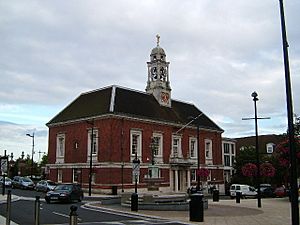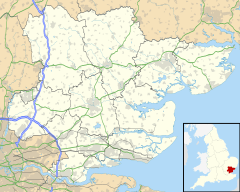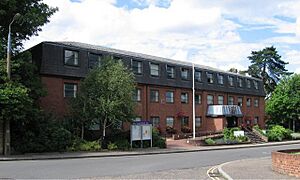Braintree, Essex facts for kids
Quick facts for kids Braintree |
|
|---|---|
 Braintree Town Hall |
|
| Population | 43,215 (2021 Census) |
| OS grid reference | TL7522 |
| District |
|
| Shire county | |
| Region | |
| Country | England |
| Sovereign state | United Kingdom |
| Post town | BRAINTREE |
| Postcode district | CM7, CM77 |
| Dialling code | 01376 |
| Police | Essex |
| Fire | Essex |
| Ambulance | East of England |
| EU Parliament | East of England |
| UK Parliament |
|
Braintree is a lively town in Essex, England. It's the main town in the Braintree District. You can find it about 10 miles (16 km) north-east of Chelmsford and 15 miles (24 km) west of Colchester.
In 2021, the town of Braintree had about 43,492 people living there. If you include nearby areas like Great Notley and Rayne, the total population was around 55,793. The Braintree district is known for its market towns, pretty villages, and a popular designer shopping area. It also has historic houses and gardens to explore.
Braintree has grown over time, joining up with several smaller places nearby. The original town was built along the River Brain. To the north was the area of Bocking. In 1934, Braintree and Bocking officially joined together. Even today, some local groups still use "Braintree and Bocking" in their names.
Major roads like the A120 and A131 go around Braintree. Trains also serve the town at two stations, which are at the end of the Braintree Branch Line from Witham. Braintree is also connected to other places around the world! It's twinned with Pierrefitte-sur-Seine in France. Plus, two towns in the United States, Braintree, Massachusetts and Braintree, Vermont, are named after it.
Contents
- What's in a Name? The Story of Braintree
- A Look Back: Braintree's History
- Braintree's Location and Landscape
- How Braintree is Run
- Fun and Entertainment: Culture, Media, and Sport
- Learning in Braintree: Education and Schools
- Shopping and Business in Braintree
- Getting Around Braintree: Transport
- Places to See in Braintree
- Nearby Villages
- Famous Faces from Braintree
- See also
What's in a Name? The Story of Braintree
The exact meaning of the name "Braintree" isn't entirely clear. In the Domesday Book from 1086, it was called "Branchetreu."
One idea is that "Braintree" comes from "Branoc's tree," named after a person called Branoc. Another idea is that it means "settlement by the river Bran or Braint." There are other rivers in Britain named "Braint" or "Bran." The last part of the name, "tre," is an old word meaning "farm" or "settlement."
A Look Back: Braintree's History
Braintree has a very long history, going back over 4,000 years. It started as a small village. During the Bronze and Iron Ages, people built their homes near the River Brain, in what's known as the Brain Valley.
Roman Times and Early Growth
When the Romans arrived, they built two important roads. A small settlement grew where these roads met. After the Romans left Britain, this settlement was abandoned for a while.
The town was mentioned in the Domesday Book in 1086, where it was called "Branchetreu." It was described as a small area of about 30 acres. Later, the Saxons lived here and named the Roman road "Stane Street" (meaning Stone Road), a name it still has today.
As more people traveled through, especially pilgrims, Braintree grew. In 1190, the Bishop of London helped the town get a special permission to hold a market. This was a big deal and helped the town become more important.
Wool and Silk Industries
From the 1300s, Braintree became known for making woollen cloth. This trade continued until the late 1800s. The town really thrived in the 1600s when Flemish immigrants arrived. They brought new and better ways of making wool cloth, which made Braintree famous. The wool products from Braintree were sold in other countries, especially Spain and Portugal.
However, in 1665, the Great Plague hit Braintree hard. Out of 2,300 people, 865 died.
The wool trade eventually faded in the early 1800s. But Braintree quickly found a new industry: silk manufacturing. George Courtauld opened a silk mill, and other companies like Warner & Sons followed. By the late 1800s, Braintree was a busy town known for both farming and textiles. It also got a railway connection to London, which helped it grow even more.
The wealthy Courtauld family played a big role in Braintree. They helped pay for many public buildings, like the town hall and the public gardens, which opened in 1888. You can still learn about Braintree's textile history at the Warner Textile Archive and the Braintree Museum.
Modern Times and World War II
During the Second World War, factories in Braintree, like Crittalls, made important war equipment, including Bailey bridges.
Braintree's Location and Landscape
Braintree is in northern Essex, about 46 miles (74 km) from London. To the south, you'll find factories and houses, while the north has more countryside where crops are grown. The town is about 150 feet (46 meters) above sea level. Essex is generally flat, and Braintree is no different.
Two rivers flow through Braintree. Pod's Brook forms a natural border between Braintree and the nearby village of Rayne. This brook then becomes the River Brain as it flows through the southern part of Braintree. The River Pant (also called the Blackwater) runs through the north of Bocking. The River Brain eventually flows into the Blackwater several miles away, near Witham.
How Braintree is Run
Braintree has two main levels of local government: the Braintree District Council and the Essex County Council. The Braintree District Council has its main office at Causeway House in Bocking End.
Braintree's first elected council was set up in 1850. In 1928, the council built the Braintree Town Hall to be its headquarters. As Braintree grew, it expanded into nearby areas like Bocking. In 1934, Braintree and Bocking officially became one larger area. In 1974, this larger area joined with other districts to form the modern Braintree District.
Fun and Entertainment: Culture, Media, and Sport
Culture and Arts
Braintree has a museum named after John Ray, a famous local naturalist. The museum shows off the town's history. It also has the Warner Textile Archive, which holds one of the largest collections of public textiles in the UK!
The Braintree Arts Theatre opened in 2009 at Notley High School. The Bocking Arts Theatre, located at The Literary and Mechanical Institute, hosts plays, pantomimes, and live shows. It's also used for community events like blood donor sessions and charity fundraisers. This historic building was given to the people of Braintree by George Courtauld and his family in 1863.
Each June, Braintree celebrates with the Braintree and Bocking Carnival. It starts with a parade of floats through the town, ending at Meadowside, where there's a fair and other fun activities.
The Braintree Musical Society puts on two shows a year. They used to perform at the Institute, but now they use the Braintree Arts Theatre.
Did you know that the famous electronic music band The Prodigy started in Braintree? Some of the band members still live nearby!
News and Radio
For local TV news, Braintree gets updates from BBC East and ITV Anglia.
The local newspaper is the Braintree and Witham Times, which has an office on High Street. There's also a regional daily newspaper called the East Anglian Daily Times.
You can listen to local radio stations like BBC Essex (103.5 FM), Heart East (96.1 FM), Greatest Hits Radio East (100.2 FM), and Actual Radio (a DAB station).
Sports Scene
Braintree Town Football Club is known as The Iron. They've played at the Cressing Road Stadium since 1923. In the 2010–2011 season, they moved up to the Conference National division. In the 2023-24 season, they were promoted back to the National League again!
Braintree Rugby Union Football Club started in 1963. They celebrated their 50th anniversary in 2013.
Learning in Braintree: Education and Schools
Braintree has several secondary schools for students aged 11-16. These include Gosfield School (an independent school), Alec Hunter Academy, Notley High School Technology College, and Tabor Academy.
For students aged 16 and older, there's Gosfield School, Notley High School, The College at Braintree, Braintree Sixth Form, and Tabor Academy. Braintree also has a special needs school called The Edith Borthwick School.
Shopping and Business in Braintree
Braintree has two main market areas that are open on Wednesdays and Saturdays. You can find them outside the Town Hall in Market Square, and along Bank Street and the High Street. The High Street is mostly for people walking, with only buses allowed to drive through.
Braintree Village, which used to be called Freeport, is a popular shopping area just outside the town. It's a "designer outlet village" with about 90 stores where you can buy designer brands at lower prices. It even has its own railway station, Braintree Freeport.
There are also several industrial areas around Braintree, like the Springwood Industrial Estate, Park Drive Industrial Estate, and Broomhills Industrial Estate. These areas are home to many businesses and factories.
Getting Around Braintree: Transport
Trains
Braintree has two train stations: Braintree and Braintree Freeport. Both are on the Braintree branch line. Trains run regularly to Witham, and some services go all the way to London Liverpool Street via Chelmsford and Stratford on weekdays and Saturdays. From Witham, you can catch connecting trains to places like Ipswich and Colchester.
Buses
Bus services in Braintree are run by different companies like Arriva Herts & Essex, First Essex, and Stephensons of Essex. Some key bus routes connect Braintree to places like Witham, Halstead, Chelmsford, Colchester, and even Stansted Airport.
Roads
The roads in Braintree are managed by Essex Highways, except for the A120, which is part of the government's main road network.
Important roads in the town include:
- The A120 connects Braintree to Bishop's Stortford, Stansted Airport, and the M11 for London to the west. To the east, the A120 goes to the A12 for Colchester and Ipswich.
- The A131 links Braintree to Chelmsford and the A12 for east London. To the north, it goes to Halstead and Sudbury.
- The B1018 connects Braintree to Witham.
- The B1053 links nearby Bocking with Finchingfield and Saffron Walden.
- The B1256 (which used to be part of the A120) goes to Bishop's Stortford through Great Dunmow.
Cycling
National Cycle Route 16, a cycling path that runs between Bishop's Stortford and Great Totham, goes through Braintree.
The Flitch Way is a path for walking, cycling, and horse riding. It follows an old railway line between Braintree and Takeley. It's a country park along its whole length. The path is named after the Dunmow Flitch Trials, a funny ceremony where couples can win a side of bacon if they can prove they've been happily married for a year!
Places to See in Braintree
Bocking Windmill, located in Bocking, offers views of the countryside. It has been partly restored, and although it doesn't work anymore, most of its parts are still inside. You can visit the windmill on certain days of the year.
The Braintree District Museum is across from the Town Hall on Manor Street. It used to be the Manor Street School, built in 1863. Now, it displays many items that show the history of Braintree and Bocking.
The Braintree & Bocking Public Gardens are on the north side of Braintree. These beautiful gardens were built in 1888 and given to the town by Sydney and Sarah Courtauld.
You can also visit several interesting churches in Braintree, including St. Michael's, St. Mary's Church, St. Peter's church, and Our Lady Queen of Peace Church.
Nearby Villages
Some villages close to Braintree include Bocking, Black Notley, White Notley, Great Notley (a newer development), Cressing, Felsted, Rayne, and Panfield.
Famous Faces from Braintree
Many interesting people have connections to Braintree:
- Henry Adams (1583–1646) – An ancestor of US Presidents John Adams and John Quincy Adams. He moved to America from Braintree around 1638.
- Mike Baker (1957–2012) – A BBC education reporter who grew up in Braintree and wrote a book about the town's history.
- Beans on Toast (born 1980) – A folk singer who went to Notley High School and Braintree College.
- James Challis (1803–1882) – A famous astronomer born in Braintree.
- The Courtauld family – A very rich family from the 1800s who owned successful silk businesses in Braintree. They gave a lot of money to the town for buildings like the Town Hall, public gardens, and the hospital.
- Rupert Everett (born 1959) – An actor who spent some of his childhood in Braintree.
- Steve Harley (born 1951) – The singer and founder of the band Cockney Rebel, lived in Braintree for a few years. He worked as a reporter for the Braintree and Witham Times.
- Lawrence D. Hills (1911–1990) – He started the Henry Doubleday Research Association in Bocking and developed a special type of plant called comfrey, useful for organic gardening.
- Giles Long (born 1976) – A triple Paralympic Gold medallist in swimming, who trained with the Braintree and Bocking Swimming Club.
- Olly Murs (born 1984) – A popular singer and TV personality, who went to Notley High School.
- Next of Kin – A pop group that had two songs in the UK top 40 in 1999.
- Andy Overall (born 1959) – The singer from the 80s band Blue Zoo.
- Katherine Parnell (1846–1921) – The sister of Sir Evelyn Wood and wife of Irish leader Charles Parnell.
- Andrew Phillips, Baron Phillips of Sudbury (born 1939) – A well-known politician and lawyer who lived in Braintree.
- The Prodigy – The famous dance music group. Their leader, Liam Howlett, went to Alec Hunter High School.
- John Ray (1627–1705) – A famous naturalist born in nearby Black Notley.
- Louie Spence (born 1969) – A dance expert and TV personality.
- Sir Evelyn Wood (1838–1919) – A high-ranking army officer and Victoria Cross winner.
See also
 In Spanish: Braintree para niños
In Spanish: Braintree para niños




